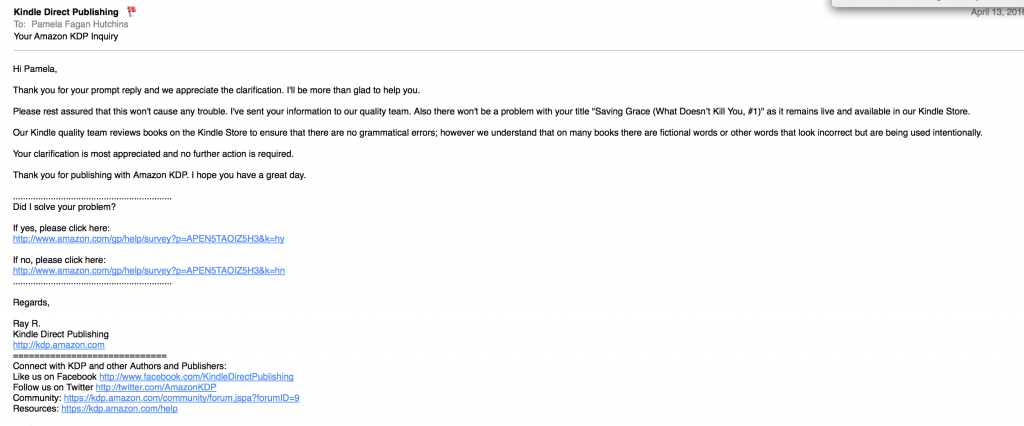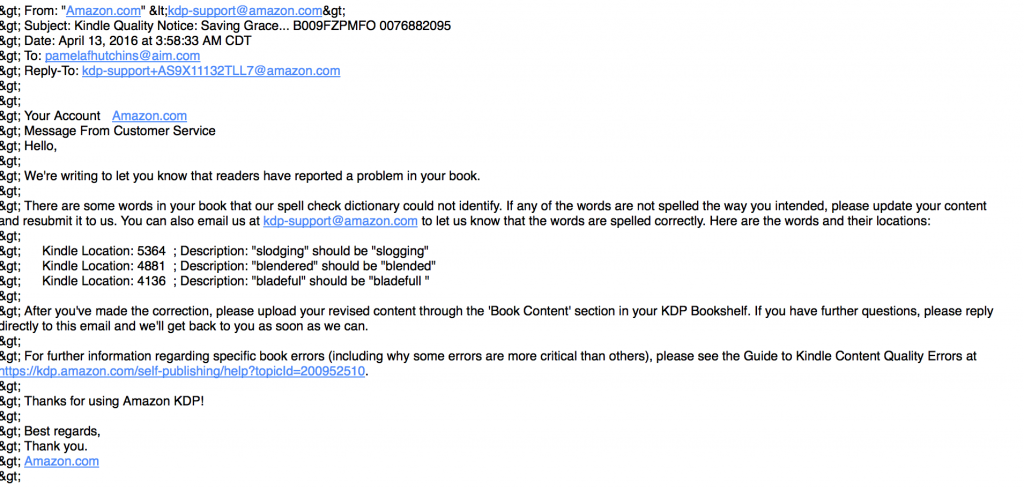I’m interested in how many of you have been contacted by Amazon about your books and “errors?” I’ve been contacted about only one of my books, and I’ve heard from them on two separate occasions. Because I don’t think it’s remotely possible that the rest of my books are error-free (because I’ve never seen an error free book by me or anyone else), I think the selection has to do with volume of downloads. The book they’ve contacted me on is Saving Grace, which has about one million downloads.
The first time they contacted me, they had found errors. Now, it is interesting to note that these were flat-out typos/misspellings that their “spell check” when uploading an ebook should have caught but never did. I was elated to know about the, and I fixed them. That was a year ago, and you can read about it, HERE.
Last week, they contacted me again about Saving Grace. But this time the words they contacted me about were not misspellings. Rather, they were artistic choices reflective of voice. That doesn’t mean that they were effective or that they were the best choices. But it does mean that they were intentional, by me and by my editor. At first I was taken aback, and worried. In the end, when I wrote a fairly strong reply back to Amazon about them, I was pleased. A human answered me and assured me that the words were fine and my book could remain published as is.
My experiences with the Amazon Quality Control mechanism have been increasingly positive, and with each one I have learned. I hope this letter share shed some light on the process for you as well. I’ve copied the correspondence in below so you can see it for yourself. The most recent is first, down through the original, just like a real email.
Now, what experiences have you guys had with this process?



Pamela
Pamela Fagan Hutchins writes overly long e-mails, hilarious nonfiction (What Kind of Loser Indie Publishes, and How Can I Be One, Too?), and series mysteries, like What Doesn’t Kill You, which includes the bestselling Saving Grace and the 2015 WINNER of the USA Best Book Award for Cross Genre Fiction, Heaven to Betsy. She resides deep in the heart of Nowheresville, Texas and in the frozen north of Snowheresville, Wyoming. Pamela has a passion for great writing and smart authorpreneurship as well as long hikes with her hunky husband and pack of rescue dogs/goat, traveling in the Bookmobile, and experimenting with her Keurig. She also leaps medium-tall buildings in a single bound (if she gets a good running start).
Doesn’t Kill You, which includes the bestselling Saving Grace and the 2015 WINNER of the USA Best Book Award for Cross Genre Fiction, Heaven to Betsy. She resides deep in the heart of Nowheresville, Texas and in the frozen north of Snowheresville, Wyoming. Pamela has a passion for great writing and smart authorpreneurship as well as long hikes with her hunky husband and pack of rescue dogs/goat, traveling in the Bookmobile, and experimenting with her Keurig. She also leaps medium-tall buildings in a single bound (if she gets a good running start).
Last year (or maybe the year before) Amazon contacted me regarding 2 minor spelling issues in Unspoken Bond. I pitched a fit because at the time the book had been targeted by someone using the “likes” and “dislikes” of the reviews as a way to harass me. After explaining to the person at Amazon about the harassment (Amazon finally put a stop to it) Amazon backed off about making me correct the minor spelling issues at the time. Fast forward a year or two and those were finally corrected. I’ve not had any emails about voice or word usage, but I do think our books were selected because of the amount of downloads and/or reviews. I think emailing authors about word usage and/or voice is a little much. Writing is an art and what is pleasing to one person isn’t to the other one, a fact seen in reviews!
Agree. We were quite irritated to be contacted about voice/art, but in the end, were relieved there was a thinking human on the other end. We want to know about typos and errors, from anyone that finds them, in our books.
It was good to see that a human stepped in (as you said) and logic prevailed. I understand their concern and the requirement to automate the process initially but,,, it would be nice for humans to first do a little more review of the messages that the automated system would like to send. Nice blog post.